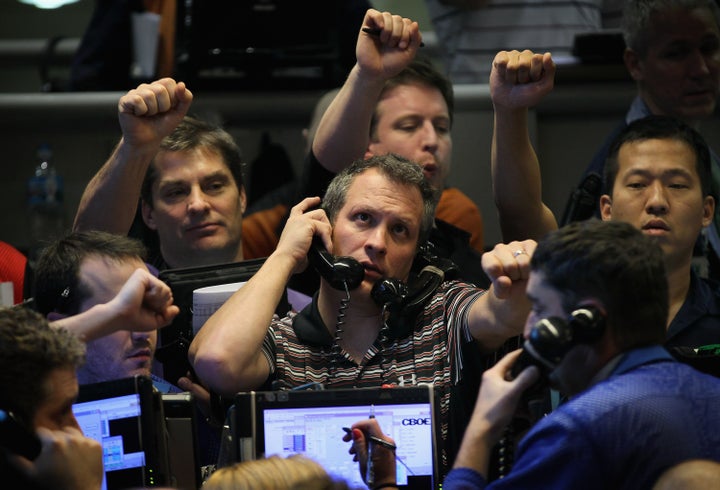
By Robert Harris, author of The Fear Index
If you want to know why the world economy is in such a mess take a trip to Waxahachie, Texas, and look at a hole in the ground - or, rather, at seventeen holes in the ground. Each is an air shaft drilled several hundred feet into the Texas limestone to link up with fourteen miles of abandoned tunnel: all that remains of the hubristic scientific dream that was once the Desertron - "The Machine in the Desert" - America's Superconducting Super Collider.
The Desertron was designed to send atomic particles accelerating to the speed of light around a circular tunnel the size of the Washington Beltway, with the objective of recreating the origins of the universe. It would have dwarfed its main rival, the Large Hadron Collider in Geneva, operated by the European Centre for Nuclear Research (CERN), by a factor of three. But sadly the only thing that ever accelerated at Waxahachie was the cost. In 1993, with $2 billion already spent, Congress decided it had had enough and the project was cancelled, saving the US taxpayer an estimated $10 billion.
At a stroke, two thousand scientific posts were wiped out, wrecking the career prospects of a whole generation of American academic physicists, whereupon a law as reliable as Einstein’s General Theory of Relativity swung into effect: the Law of Unintended Consequences, colloquially known as Murphy's Law.
For what did many of these physicists do? They went into Wall Street and became quantitative analysts, or "quants" as their scientific colleagues derisively call the traders. And what did the quants do? They used their mathematical prowess to price bonds and risk. In particular, throughout the 1990s, they provided much of the technical brainpower behind the so-called "derivatives" business – the mind-swimmingly complex bundles of credit default swaps and collateralized debt obligations – that have infected the financial markets like a recurrent fever for the past five years. And how much did the US taxpayer have to pay to rescue the financial system as a result? $3.7 trillion. It would have been thirty times cheaper, and much more harmless, to have built the Desertron.
Those first few years of the 1990s, when scientists moved decisively into finance, may one day be seen to represent the decisive inflection point of our age: that era when the Soviet Union dissolved and America reached the pinnacle of its power; when Francis Fukuyama published The End of History and the markets reigned supreme; when the scientists at CERN invented the worldwide web, and when Moore's Law -- the legendary formulation of Intel’s founder, Gordon Moore, that computer processing power will double every eighteen months as costs halve -- really took hold (processing at CERN that in 1993 used to require a highly classified $15 million Kray supercomputer could now be done by a $200 X-Box).
I don't think our democratic system has remotely come to terms with the effects of the remorseless growth of computing power. Algorithms now account for more than 70 per cent of the trades on the New York Stock Exchange. These computer-operated strategies come in two basic forms: High Frequency Trading systems (HFTs) which may hold positions for only a few milliseconds, and so-called "black box" programs that aim to predict the movements of everything, from commodities, to currencies, to bonds, to general stocks. Mostly these use extrapolations from past financial data to forecast the markets; a few are starting to use information such as trends on the internet to anticipate human behavior. Thanks to computers, the average time a share is now held by its owner in the US is 22 seconds.
Researching my novel (The Fear Index, published by Knopf on 31 January) involved spending an instructive day with one algorithmic hedge fund in Geneva. The company moved to Switzerland from London in 2010 mainly to avoid high British tax rates and the threat of regulation from the Euopean Union, but also because CERN offered a potential source of recruits.
The traders -- young, casually dressed, quiet, donnish -- are about as far removed from the stereotypes of Oliver Stone's movies as it is possible to get. They sit at their screens and observe the trades -- in twenty minutes I watched as one particular algorithm made $1.5 million -- with all the passivity of pilots in a fly-by-wire jumbo jet. There is something vaguely creepy about seeing young men (they are mostly men) who twenty years ago would have been in the laboratory or the lecture theatre now devoting themselves to making money. As Emanuel Derman put it in My Life as a Quant: "When physicists pursue the laws of the universe, it seems selfless. But watching quants pursue sacred laws for the profane production of profit, I sometimes find myself thinking disturbingly of worshippers at a black mass."
The fund employs nobody in its algorithmic department who does not have a PhD in one of the natural sciences, preferably peer-reviewed in the top 15 per cent; even economics is considered too "soft'' a degree. Indeed, knowledge of economics and business is seen, if anything, as a potential handicap. Quants deal purely with formulae, unfettered from any sentimental attachment to companies, workers, investors, nations. One told me that he knew almost nothing about what he was trading: "It's all just numbers to me. It makes the job easier."
Those numbers have become so huge, they are hard to grasp. One graphic illustration is provided by the events of May 6 2010, the day of the so-called "flash crash," when the Dow dropped by almost a thousand points before staging a sharp recovery. On that one day, 19.1 billion shares were traded on the New York Stock Exchange -- more than were traded during the entire decade of the 1960s. To a large extent, the crash was actually a function of the volatility created by that dizzying volume of transactions. Much of it wasn’t conventional buying and selling at all, but so-called "sniping" or "sniffing" by HFT algorithms, trying to sense how much liquidity was available by making bids and then cancelling them fractions of a second later: a frantic game of pass-the-parcel the official inquiry afterwards described as a "hot potato" effect.
At one stage, 100 million shares were being traded per minute: ten times the normal volume. The electronic Arca exchange began to break down under the strain and had to be temporarily taken off line. It was at this feverish juncture, at around 2:30 pm in Chicago, that an algorithmic program entered the market, charged with selling 75,000 "E-minis" -- electronically traded S&P 500 future contracts -- with a notional value of around $4 billion. A myth subsequently arose that the flash crash was due to a trader's "fat finger", selling ten times more contracts than he intended. The truth is more interesting. To limit the impact on price of such a large disposal, the algorithm was programmed to restrict its trading so that its volume of sales averaged no more than 9 per cent of the total market at any given moment. The disposal was therefore predicted to take up to four hours. But with the market ten times its normal size, the algorithm adjusted accordingly and proceeded to complete its task in just nineteen minutes, sending the Dow into free fall.
It was a classic example of the intelligent stupidity of computers. A computer will famously prefer for accuracy a clock that has stopped to a clock that is five seconds slow, on the grounds that it is at least precisely correct once per day. Similarly, the computer models used to price derivatives in the 1990s and early 2000s assessed the risk that house prices might fall in the USA as a possibility so remote, it was roughly comparable with a giant asteroid hitting in the earth. (One might observe that this is exactly the sort of thing that might be expected to happen if quants rule the earth, if trading is reduced to a series of algebraic formulae, and if the job becomes "all just numbers to me".)
The twenty-year trajectory that has brought us to our present financial crisis might be summed up roughly thus: quants and traders begat derivatives; derivatives begat the credit crisis of 2008; the credit crisis of 2008 plunged governments all around the world into deep debt as they struggled to avoid a second Great Depression; the sovereign debt crisis that resulted threatens to break up the Eurozone and cause some nations to default; the threat of debt and default are making it harder to gain the economic momentum to pay the cost of the debts.
There is an Orwellian, science fiction quality to all this, as if the global financial machine and its white-coated technicians have slipped beyond human control. When the US regulators came to analyze the May 6 2010 crash, they had to collect 25 gigabytes of data -- more than 300,000 files -- simply to reconstruct a sequence of events that lasted in real time less than fifteen minutes. Politicians have shown that they cannot control this global behemoth. How can they? Even the people supposedly running the system confess they do not fully understand it. This explains, I think, the curious sense of apathy with which ordinary people put up with it all. How does one rage against something as abstract as exchange traded futures (ETF), a trillion-dollar industry, now being brought to us by the same quants and computer systems that gave us derivatives, and which some analysts believe is headed the same way?
In 1959, the British novelist and physicist C P Snow delivered a famous lecture about what he called "the two cultures" -- the humanities and the sciences -- and the failure of the one to understand the other. "A good many times," Snow said, 'I have been present at gatherings of people who, by the standards of the traditional culture, are thought highly educated and who have with considerable gusto been expressing their incredulity at the illiteracy of scientists. Once or twice I have been provoked and have asked the company how many of them could describe the Second Law of Thermodynamics. The response was cold: it was also negative. Yet I was asking something which is the scientific equivalent of 'Have you read a work of Shakespeare's?'"
The gulf in understanding is now not so much between the humanities and the scientists as between bewildered humanity and a global financial system that seems both utterly mysterious and highly unstable. Gordon Moore himself, a few years ago, expressed his fears about his own law: "It can't continue forever. The nature of exponentials is that you push them out and eventually disaster happens." We need as a species to wake up to this danger before science fiction comes true, Darwinian rules apply, and we discover that it is not so much the machines that are working for us, as we who are working for the machines.
Robert Harris is the author of The Fear Index, a thriller set in the world of international finance at a moment when the markets have slipped beyond human control. What if every asset you had could be obliterated in a second? How real is the threat?
CORRECTION: A previous version of this post mistakenly stated a "flash crash" occurred on May 6, 1010. It occurred on May 6, 2010.
